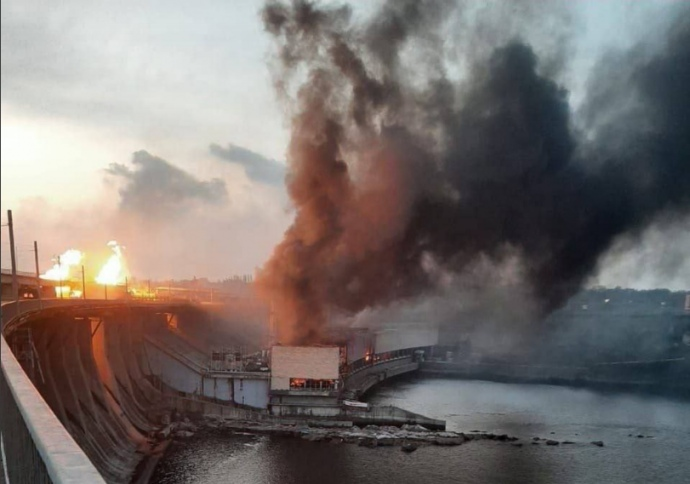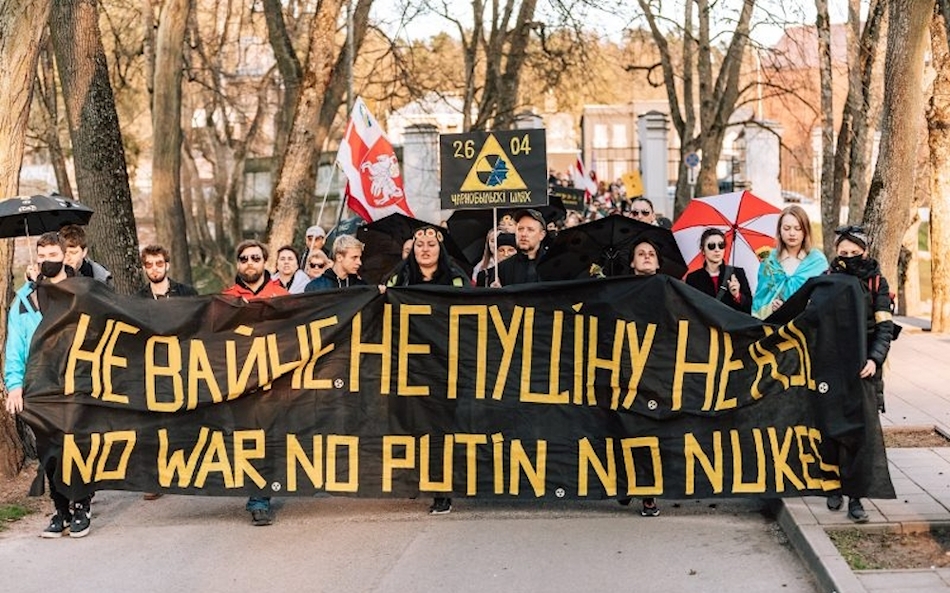UWEC Work Group editorial team
Large energy facilities of Ukraine (such as hydroelectric power plants and nuclear power plants) are again being attacked by the Russian Federation in order to sow panic. This, as we explained earlier, indicates the systemic risks associated with the creation and use of large, dangerous energy facilities, such as Zaporizhia NPP or Dnipro HPP.
In Zaporizhia in the morning of March 22, numerous rockets were launched, with estimates ranging from two to eight hits targeting the Dnipro HPP.
Judging by the pictures published on the network, a trolleybus with people who were going to work and did not suspect anything was destroyed right on the dam. Eternal memory to the innocent victims of Russian aggression…
The machine room, where there are containers with technical oils and other flammable liquids, is on fire. Power equipment is likely damaged. Transformers may also be burning or destroyed. As a result, contamination of the Dnipro River with oils and petroleum products used at the hydroelectric power station is observed.
The head of Ukrhydroenergo Ihor Syrota said that both engine rooms of Dnipro HPP (No. 1 and No. 2) were out of order, while the foundation of the engine room of HPP-2 was damaged, which will require long-term repairs. All the water that used to go through the turbines will be discharged without generating energy. There is no risk of a dam breach.
Indeed, significant damage to the dam itself is extremely unlikely due to its massiveness. It is well known that repeated shelling failed to significantly damage the Kakhovka HPP (only the lock was damaged by shelling) and it was blown up from the inside by retreating Russian troops. The great dams of the USSR were built taking into account the threat of even a nuclear attack.
In the highly unlikely event of uncontrolled significant water discharge through the dam, the excess water would be accommodated by the vast empty capacity of the former Kakhovka Reservoir. As rightly pointed out by environmental expert Natalia Gozak, the total capacity of the Dnipro HPP reservoir is 3.3 km3, and all this water can be accommodated multiple times in the dried-up basin of Kakhovka (with a capacity of 18 km3).
Therefore, under any scenario, neither the Zaporizhia NPP nor the settlements on the shores of the former reservoir are threatened by flooding. There is only a small possibility that there will be a threat of flooding of the southern micro-districts of the city of Zaporizhia immediately downstream of the dam.
The increased risks for the Zaporizhia NPP as a result of the Russian attack are not associated with the prospects of flooding, but with the cessation of electricity supply via one of the two power lines, which has happened before.
Russian propaganda began actively spreading fears of a “tsunami and atomic apocalypse in the event of a breach of the Dnipro HPP” as early as 17 hours before the attack. It continues to spread these fears even now, after the attack. This is a deliberately planned campaign of intimidation, where the hypothetical breach of the hydroelectric power plant and the “possible” damage to the nuclear power plant are used as the main means to sow panic. The threat of the dam’s destruction serves as a powerful psychological weapon aimed at the vulnerable population.
The capacities of Dnipro HPP are very useful for increasing the maneuverability of the energy system of Ukraine, but are not critical for its functioning in general, especially after connection to the pan-European system. An attack on the country’s power system may lead to local blackouts, but it will not become critical, since spring has already arrived and there is no threat of freezing of cities.
European banks have already allocated substantial funds for the operational repair and modernization of both the Dnipro HPP (EUR 200 million from the European Bank for Reconstruction and Development) and the rest of the Dnipro Cascade (EUR 130 million from the European Investment Bank). There are similar lines of financing for the restoration of CHP and transmission lines. Therefore, we hope that today’s attack should not lead to a long-term decrease in the efficiency of the power system.
Russia counts on its strikes to exert powerful psychological pressure on the population of Ukraine, but knowing the actual state of affairs and understanding the means to address the problems created by the attack, there is no need to succumb to panic.
Main image credits: photo by Denys Shmyhal







